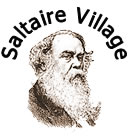| The Changing Face of Waste
There was no real problem with waste in Sir Titus Salt’s Saltaire. Everyone had an open fire in their home on which to burn waste paper and other combustibles. Food waste was fed to livestock, especially pigs. Sir Titus used to make £50 per year by selling waste food which was swept from the floor of his dining hall at the Mill. Other items were too valuable to throw away. They were re-used to extinction, or were cannibalized for other repairs. Items of clothing were passed down through the family until work out. Packaging was done on site at shops such as the Co-op (at 30 – 31 Caroline Street) where essentials such as flour or sugar were bought in bulk and dispensed in paper bags weighed out at the counter. Everyone knew which assistants were most generous or heavy handed and would queue for them.
In Bradford and other industrial centres, the Government realized that they had to grasp the nettle of public health, which they had left for far too long to the discretion of Local Authorities. In 1875 a Public Health Act was passed which, among other things, required Local Authorities to remove waste. Householders were required to keep waste n a “moveable receptacle” (the first dustbin) which the Authorities had to empty each week.
Then in 1956, the Clean Air Act led to a decrease in the number of open fires in homes, to be replaced by gas, electricity and oil. As a result, rubbish which would have been burned was now waste which had to be collected. Between 1930 and 1950 the use of plastics was more prevalent, presenting a huge problem of disposal. Glass and metals were still very expensive to produce and were reclaimed for recycling. Like me, many of you will remember rag and bone men on the streets, giving donkey stone for whitening front doorsteps in exchange for rags and metals. And do you remember taking back empty bottles? Remarkably, in 2005, one third of all household waste was food – a huge amount when you remember Third World hunger.
Roger Clarke |

